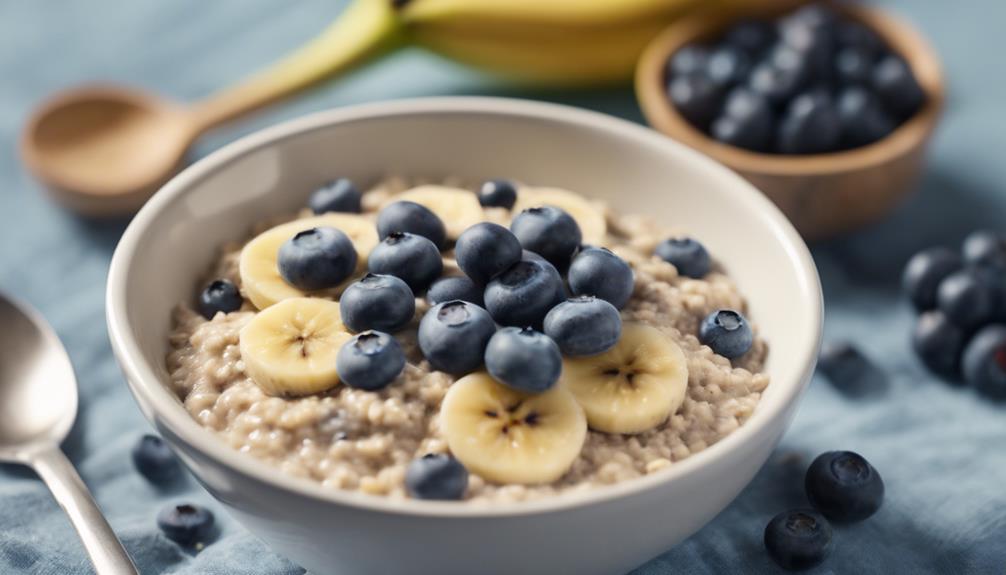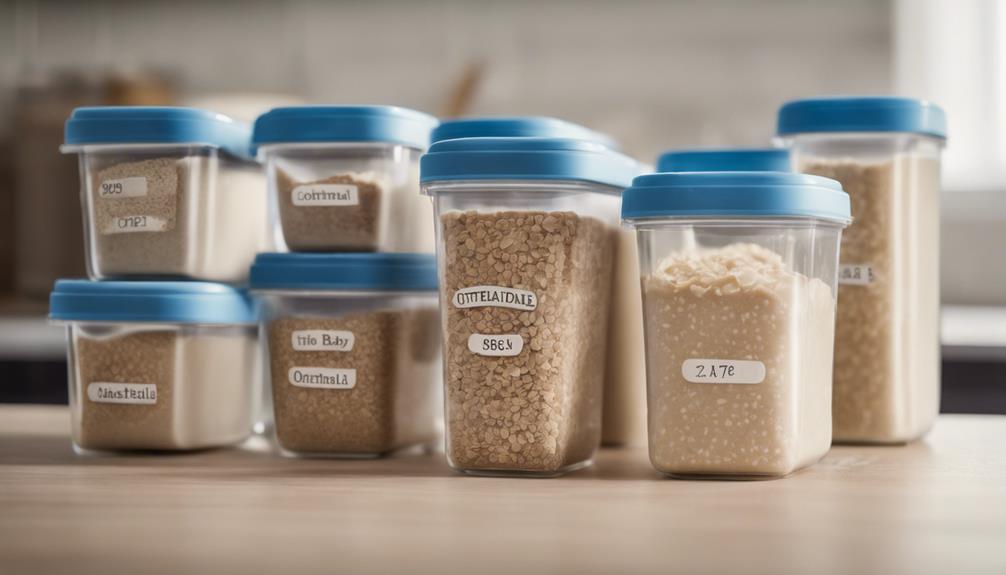When making homemade baby oatmeal, selecting the correct oats is important for essential nutrients. Opt for oatmeal suitable for your child's age. Grind them finely for a smooth texture. Add liquid gradually for the desired consistency. Enhance nutritional value with healthy flavorings and fats like nut butter. Controlling ingredients ensures a healthy meal. This simple recipe guarantees a nutritious breakfast choice for your little one. Remember, every step is essential for providing your baby with a balanced diet.
Key Takeaways
- Grind oats to a fine powder for smooth texture and easy digestion.
- Customize with fruits, nut butters, and spices for added flavor and nutrients.
- Cook oats with liquid until creamy and adjust consistency to desired thickness.
- Store leftovers in the fridge for up to three days for convenient reheating.
- Start with small portions, use organic ingredients, and consult a pediatrician for guidance.
Baby Oatmeal Types
When selecting oatmeal for your baby's meals, consider the different varieties available to match their developmental stage and preferences.
Baby oatmeal comes in various forms such as oatmeal cereal, quick oats, old fashioned rolled oats, and steel cut oats, each catering to different stages of your baby's development.
Oatmeal cereal, suitable for infants around 5+ months, is made by grinding old fashioned oats into a fine powder.
Quick oats, perfect for babies 6+ months, are convenient with a quick cooking time of just 1 minute.
Old fashioned rolled oats offer a creamy texture and are versatile for babies also at 6+ months.
For a heartier option, steel cut oats are appropriate for babies at the same stage, although they require longer cooking.
Selecting the right type of oatmeal for your baby's meals is crucial to ensure they receive the necessary nutrients for their growth and development.
Baby Oatmeal Recipe

Consider creating your own homemade baby oatmeal as a nutritious breakfast option that's quick and easy to prepare for your little one. Making baby oatmeal at home guarantees you understand precisely what ingredients are going into your baby's food, providing a wholesome meal without added preservatives or sugars.
Follow these simple steps to whip up a batch of homemade baby oatmeal:
- Grind Oats: Begin by grinding old-fashioned rolled oats into a fine powder using a blender or food processor. This ensures a smooth texture that's easier for babies to digest.
- Add Liquid Gradually: Slowly mix in water or breast milk/formula to the ground oats until you achieve the desired consistency. Thinner oatmeal is suitable for younger babies, while thicker textures may be more appropriate as your baby grows.
- Enhance Nutrients: Think about adding optional flavorings like mashed fruits or vegetables, and integrate nutrients like healthy fats and iron-rich foods to boost the nutritional value of the oatmeal for your little one.
Nutritional Information

For insight into the nutritional content of homemade baby oatmeal, refer to the following information. A serving typically contains around 150 calories, 22g of carbohydrates, 5g of protein, and 5g of fat.
This nutrient-rich meal also offers 3g of fiber, 5g of sugar, and essential vitamins and minerals such as Vitamin A, Vitamin C, calcium, and iron.
Homemade baby oatmeal serves as a balanced meal for your little one, providing a mix of macronutrients and important nutrients necessary for their growth and development.
By preparing this wholesome dish at home, you have the advantage of controlling the ingredients, ensuring your baby receives a nutritious meal tailored to their needs.
Importantly, the nutritional information provided is approximate and can vary based on the specific ingredients used in the recipe.
Homemade baby oatmeal offers a convenient and wholesome option for your baby's diet, packed with essential nutrients for their well-being.
Preparation Steps

To prepare homemade baby oatmeal, start by grinding old-fashioned rolled oats into a fine powder to create the base for this nutritious meal. Follow these steps to make a delicious and wholesome meal for your little one:
- Grind Oats:
Use a blender or food processor to grind the old-fashioned rolled oats until they form a fine powder. This will guarantee a smooth texture for your baby's oatmeal.
- Cook with Liquid:
Combine the ground oats with water, breast milk, or formula in a small saucepan. Cook over low heat, stirring constantly until the mixture becomes creamy and thick.
- Customize and Adjust:
Add optional flavorings like mashed fruits, nut butter, or a pinch of cinnamon for extra taste. Adjust the consistency by adding more liquid for younger babies or less for older ones. Remember to store any leftovers in the fridge and use them within three days to uphold freshness.
Serving Suggestions

Enhancing the flavor and nutritional value of your homemade baby oatmeal can be easily achieved by incorporating a variety of fresh fruits, vegetables, and nut butter toppings.
For a burst of natural sweetness and added texture, consider adding chopped berries, bananas, or sautéed apple or pear on top of the oatmeal. You can also mix in applesauce or drizzle nut and seed butter for a creamy and flavorful touch.
As your baby grows older and is ready for more adventurous flavors, introduce soft fruits like mashed banana or avocado to create a creamier consistency. Pureed sweet potato is another excellent option to add natural sweetness and essential nutrients to the oatmeal.
Remember to grate or mash fruits and vegetables finely for younger babies to make it easier for them to consume. These serving suggestions not only enhance the taste but also offer a variety of nutrients to support your baby's growth and development.
Baby-Led Weaning Options

Considering baby-led weaning options with oatmeal, you can offer whole oats or oatmeal in a baby-friendly form to encourage self-feeding and independent exploration of textures and tastes.
When opting for baby-led weaning with oatmeal, here are some soft and cooked options that can help your baby develop fine motor skills and healthy eating habits:
- Soft Oatmeal Balls: Shape soft, cooked oatmeal into small balls that are easy for your baby to grasp and feed themselves. These balls provide a great opportunity for your little one to practice self-feeding and explore different textures.
- Oatmeal Fingers: Cut soft, cooked oatmeal into finger-sized pieces that are perfect for your baby to pick up and eat independently. This option allows your baby to enhance their fine motor skills while enjoying a nutritious meal.
- Controlled Intake: Baby-led weaning with oatmeal enables your baby to control their food intake, fostering healthy eating habits and allowing them to experiment with various flavors and textures.
Storage Tips

When storing leftover baby oatmeal, maintain freshness by placing it in an airtight container in the fridge for up to 3 days. Ensure safety if the oatmeal contains breast milk or formula by following milk storage guidelines. To serve the oatmeal again, add hot water to thin it out as it thickens over time. Reheat the leftover oatmeal with water or breast milk in the microwave or on the stovetop for convenience. For future use, consider freezing extra baby oatmeal in ice cube trays. This method allows for easy storage and portioning when needed.
| Storage Tips | |
|---|---|
| Store in Fridge | ✔ |
| Use Airtight Container | ✔ |
| Follow Milk Storage Guidelines | ✔ |
| Thin Out with Hot Water | ✔ |
| Consider Freezing in Ice Cube Trays | ✔ |
Additional Flavorings

To enhance the taste and nutritional value of homemade baby oatmeal, consider incorporating optional flavorings such as pureed fruits, nut butters, ground spices, and superfoods. Here are some ways to add variety and nutrients to your baby oatmeal recipes:
- Pureed Fruits: Introduce flavors like banana, peach, mango, avocado, or apple by blending them into a smooth consistency. These fruits not only enhance the taste but also provide additional vitamins and minerals to your baby's meal.
- Nut Butters: Mix in a dollop of peanut butter or almond butter for a creamy texture and a boost of protein and healthy fats. Nut butters can add richness and depth to the oatmeal while increasing its nutritional value.
- Ground Spices: Sprinkle a pinch of cinnamon, cardamom, or nutmeg for a subtle yet aromatic flavor profile without the need for added sugars. These ground spices can elevate the taste of the oatmeal without overwhelming your baby's palate.
Experiment with different combinations of flavorings to not only provide additional nutrients but also to encourage a diverse palate in your little one from an early age.
Frequently Asked Questions
How Do I Make My Own Baby Oatmeal?
To make your own baby oatmeal, grind oats into a powder, mix with water or milk, adjust thickness as needed, and add fruits or veggies for flavor. Store leftovers in the fridge for up to 3 days.
Is Oatmeal Nutritious for Babies?
You bet oatmeal is a nutritious powerhouse for babies! Packed with iron, zinc, and fiber, it supports growth and development. Add some vitamin C for better iron absorption, creating a balanced and wholesome meal.
Is Homemade Baby Oatmeal Safe?
Yes, homemade baby oatmeal is safe as you control the ingredients. Grind rolled oats into powder, adjust consistency with breast milk or formula, and store leftovers in the fridge. It's a nutritious and cost-effective choice for your baby's diet.
What Is the Best Oatmeal for Babies?
For babies, the best oatmeal depends on age, preferences, and chewability. Rolled oats offer nutrition, quick oats are convenient, steel-cut oats are hearty. Oatmeal cereal suits early eaters. Prepare right for safe and enjoyable meals.
Conclusion
To wrap up, creating homemade baby oatmeal is a straightforward and nourishing choice for introducing solids to your little one.
By following the uncomplicated recipe provided and incorporating different flavors and textures, you can guarantee that your baby receives a well-balanced and wholesome meal.
Keep in mind storage tips and serving suggestions to make mealtime enjoyable and stress-free.
With a bit of creativity and preparation, you can nourish your baby's developing body and taste buds with homemade goodness.










